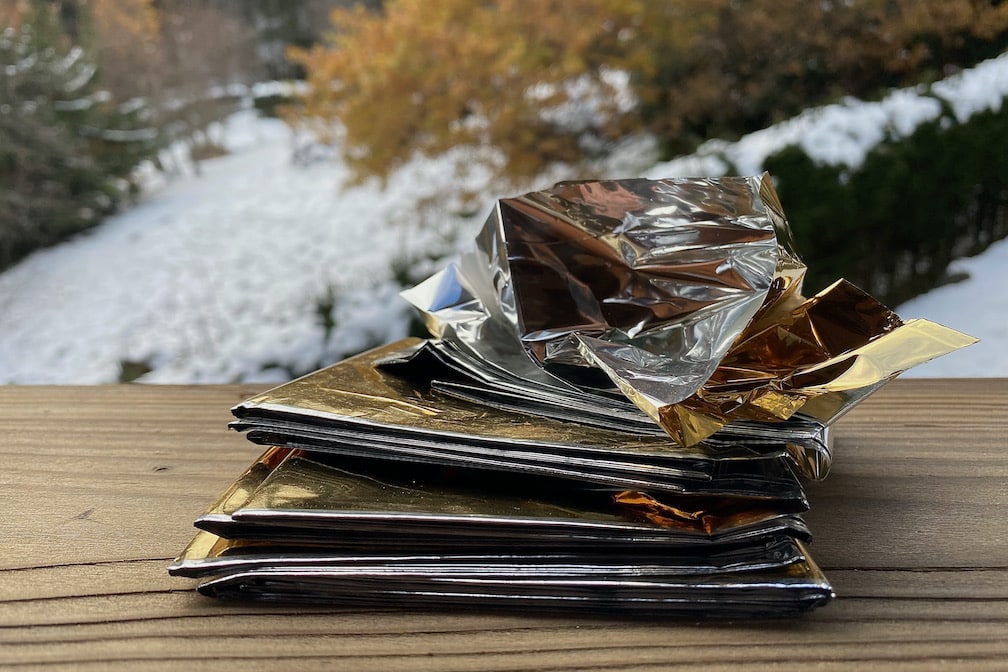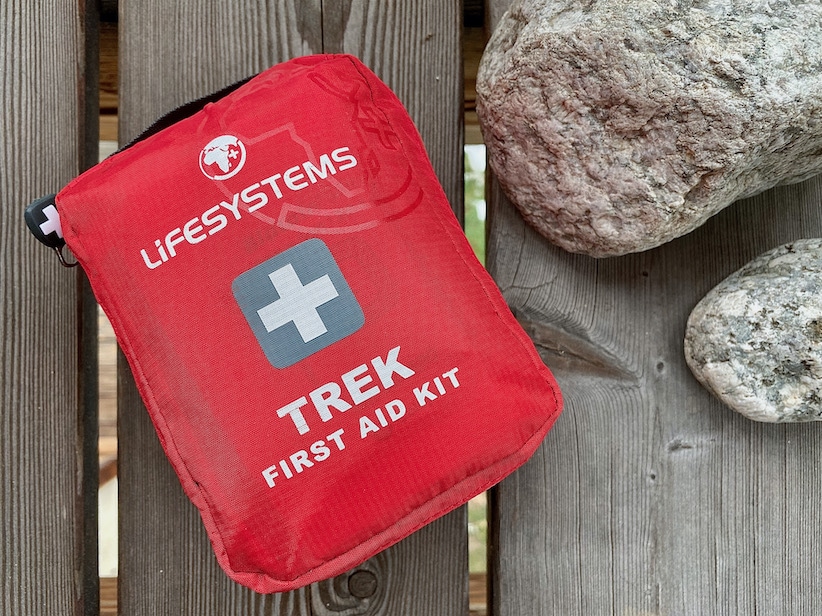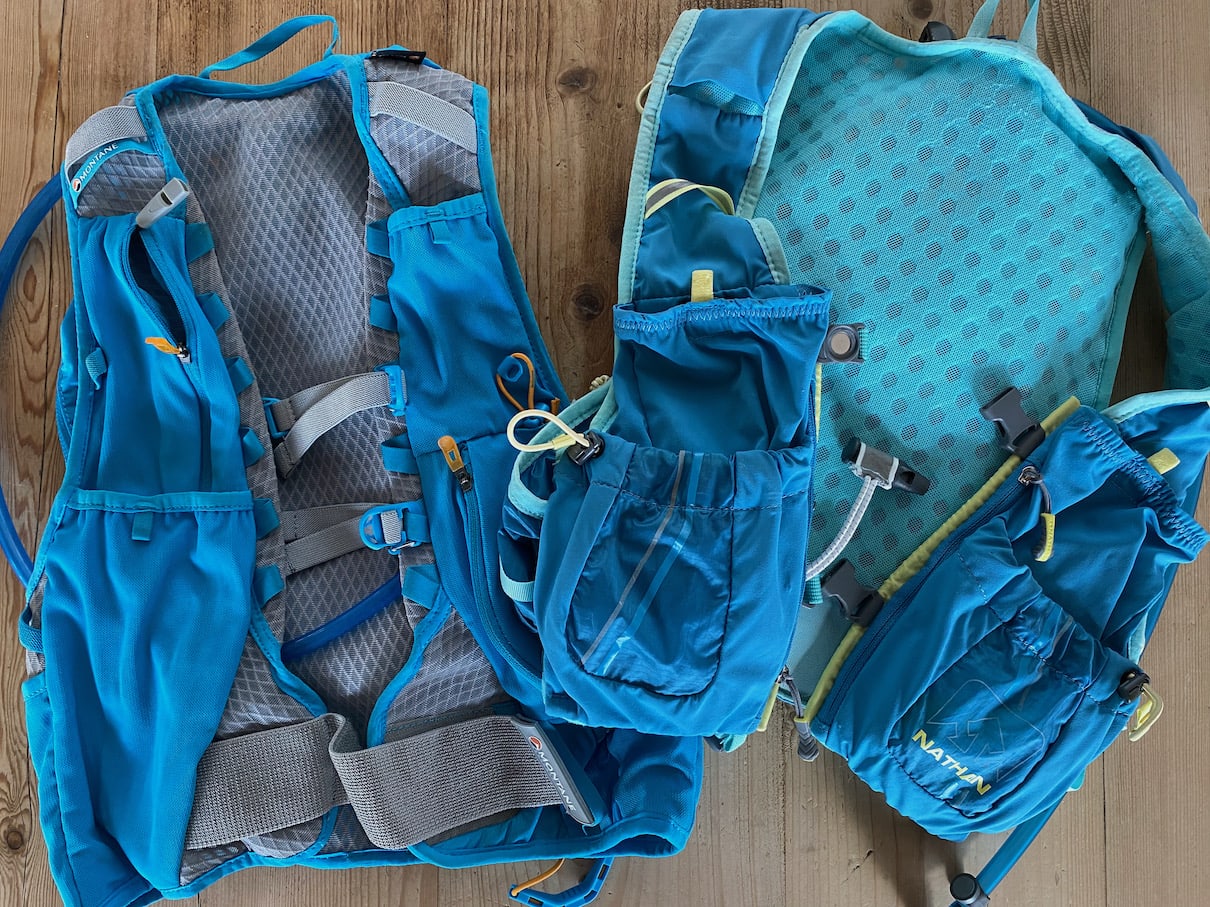Keep your first aid kit simple and practical
Carrying a small first aid kit in your running vest can help you deal with trips or falls on the trail until you get home or need further medical treatment.
There is a range of band aids, bandages and dressings of all different sizes, and many types of wipes. The items you carry should help deal with the basic running injuries such as a cut, blister, support for a sprained ankle or muscular strain.
As well as having a small first aid kit:
- Take your mobile phone in case of an emergency and for your personal safety.
- Carry ID including emergency contact details, information if you have a pre-existing medical condition, and if you are allergic to common medical treatments. This is particularly important if you are found unconscious.
- Bring some cash, enough for a taxi if needed or some food or drink.
- Wear sunscreen and lip protection. There are great pack-size 2 in 1 sun protection creams with a lip balm stick. Remember to reapply during the day.
A basic trail running first aid kit
Waterproof ziploc bag
Keep your first aid kit items in a waterproof ziploc bag to ensure sterile supplies remain clean and dry for when you need them.
A survival blanket
Also called a space blanket, a survival blanket is a lightweight foil blanket that trail runners must carry when racing ultras. The blanket protects from the cold, heat, rain and wind if you are injured, in a stressful situation and waiting for help.

Most survival blankets have a gold side and a silver side. When the gold side is outer, this protects you from the cold by reflecting your heat back towards your body. When the silver side is outer, this protects you from the heat as the silver side reflects the sun’s rays.
The size of foil blanket specified by most ultra-races is 1.4 m x 2 m minimum and are normally single use. There are races that require you to carry 2 x space blankets.
Many races now have ‘heat-wave’ and ‘bad-weather’ kits on top of the obligatory equipment. Race Directors can activate a particular kit based on the weather forecast, and inform runners before packet pick-up of the additional kit they need to present and carry for the duration of the race.
Self-adhesive elasticised bandage
This is a vital piece of first aid kit as it can be used as a bandage or as strapping for a sprained ankle. It is a compulsory item for most ultra-races and a size is usually specified, so always check the obligatory equipment for your race.
For example, UTMB requires 100 cm x 6 cm minimum; UTCT requires 100 cm x 5 cm minimum.
Antiseptic and alcohol wipes
Antiseptic wipes are generally sting free and can be used to clean grit and dirt from a cut or scrape before applying a band aid or dressing. Alcohol wipes are great at cleaning an area ready for application of a blister pad which we discuss below.
Band aids
Band aids of a few different sizes are useful in any first aid kit for cuts and scrapes. Some races require a square of gauze as an alternative to band aids, as this can be used in combination with the self-adhesive elasticated bandage for a more severe cut.
Blister pack
There are generally two things that can end your race early. Your head and your feet.
– Todd Nardi, our favorite dirtbag medic
Many of us experience blisters during ultra-races but blisters can occur at any time, even during long training runs. Our challenge is to respond quickly to a hot spot and reduce the friction in that area as much as possible, to prevent a painful and potentially race-ending blister.
To be able to keep running, particularly during a race, we should be confident in being able to deal with a blister on the trail or at the next aid station.
Even if you’re not prone to blisters, a basic blister pack is an essential part of a trail runners first aid kit and should include alcohol wipes, blister pads / blister covers, and a safety pin, needle or surgical blade.
It is important to note that if you use anti-friction cream on your feet, a blister pad will not stick. First clean the hot spot or blister and surrounding area with an alcohol wipe to remove the anti-friction cream, then let the area dry fully before applying the blister pad.
If you need to drain a blister, by popping it, the alcohol wipe can be used to sanitize your safety pin, needle or surgical blade.
Example of a trail running first aid kit
For the last 10 years of trail and ultra running, training and racing, I have been maxing-out the bag the space blanket is in, by adding my personal first aid kit items.
This pack has been my go-to set up for all UTMB races; Tahoe 200; Moab 240; Ouray 100; Barkley marathons; the Haute Route and many more mountain days, multi-day adventures and races. In all of these races, the alcohol wipes have been used and blister pads applied which were then topped up from a drop bag before heading back out there.
Find what works for you and have confidence in what you’re carrying.
Additional items
If you are heading out for a big mountain day or a multi-day adventure your kit could include the following first aid supplies:
- K-tape pre-cut into lengths to provide support to joints and muscles. This thin, flexible tape can also be useful to protect feet from hot spots.
- A fine-tipped pair of tweezers to remove splinters and ticks, but check the correct technique first, so you don’t leave their heads burrowed in. If ticks are a problem in your area you may consider running with a specific tick removal tool.
- Medical gloves are a great idea, not just from protecting yourself or others from infection, as they can be used as waterproof gloves.
- A very small pair of scissors to cut dressings or K-tape.
- A soft flask with filter so you can filter water on the go and stay hydrated and healthy however remote your location. Many are good for filtering up to 1000 liters of water.
- Anti friction cream if you have areas prone to chafing. Top tip! If you don’t have any anti friction cream, a spot of sunscreen works too because of the zinc.
And when racing ultras that allow a drop bag, you could put a more substantial first aid pack, with extra supplies and first aid kit items, in your drop bag.

Calling for help
For a serious fall or incident requiring medical attention and emergency evacuation, get help as quick as possible. Always take your mobile phone with you, particularly if you are going out for a long run or running in a remote area.
Make sure your phone has sufficient charge in case you need to call for help. You can put your phone in flight mode to conserve battery, and then turn phone cell service on in an emergency. If you do have to call emergency services, stay calm, give them all the details and listen carefully to their instructions.
Emergency rescue numbers
- Europe 112
- USA/Canada 911
- UK 999
For all other countries, check the emergency rescue number of your locality. Some mobile phones can redirect 911 calls, but this should not be relied upon.
A Personal Locator Beacon, PLB for short, is designed to alert rescuers to a life threatening situation and works when your cell doesn’t. Lightweight and compact satellite communicators, such as Garmin inReach Mini and Ocean Signal rescumeME PLB1, provide off-grid contact with fast and accurate positioning.
Survival whistle
A survival whistle is small, lightweight and takes up virtually no space. Most running vests have a built-in whistle, it can be part of the chest strap or in a zippered pocket, so it is quick and easy to access.

On the Montane Claw 14L (left) and the Nathan Vapor Airess 7L (right) running packs, emergency whistles can be seen extending from zippered pockets on the runners right.
It is a good idea to know where the whistle is on your running pack before you head out for a run or make it a priority purchase if you don’t have one. The sound of a whistle carries further than the sound of a voice. If it is foggy for example, and you get lost, using your whistle will be more effective than shouting.
To attract attention, give 6 loud blasts on your survival whistle, wait 1 minute and repeat. This is recognized as the international distress signal.
If you are trail running in the dark, and need rescuing at night in difficult terrain, give 6 flashes of your running headlamp or reflector, wait 1 minute and repeat. Remember to flash your light on the ground, not at an approaching helicopter as this will affect the pilot’s night vision.
In response, rescue teams should give 3 whistle blasts or 3 flashes of a headlamp.
Quick tips and summary
Whether you are running with friends or on your own; heading out for long run on well used trails or planning a remote mountain route; prepare, be safe and responsible.
You could carry many more items than we have listed above. It very much depends on the workout you are planning, your needs and locality. Bear spray may be part of your essential trail running safety kit.
Before a run it could be as simple as asking yourself questions like:
- If I fall and cut my leg, do I have a band aid I could apply?
- In case of an emergency, can I call someone?
- My shoes are new, if I get a hot spot do I have a blister pad I can put on?
Keep your trail running first aid kit simple, practical and know how to use what you carry.
Thank you for reading.


